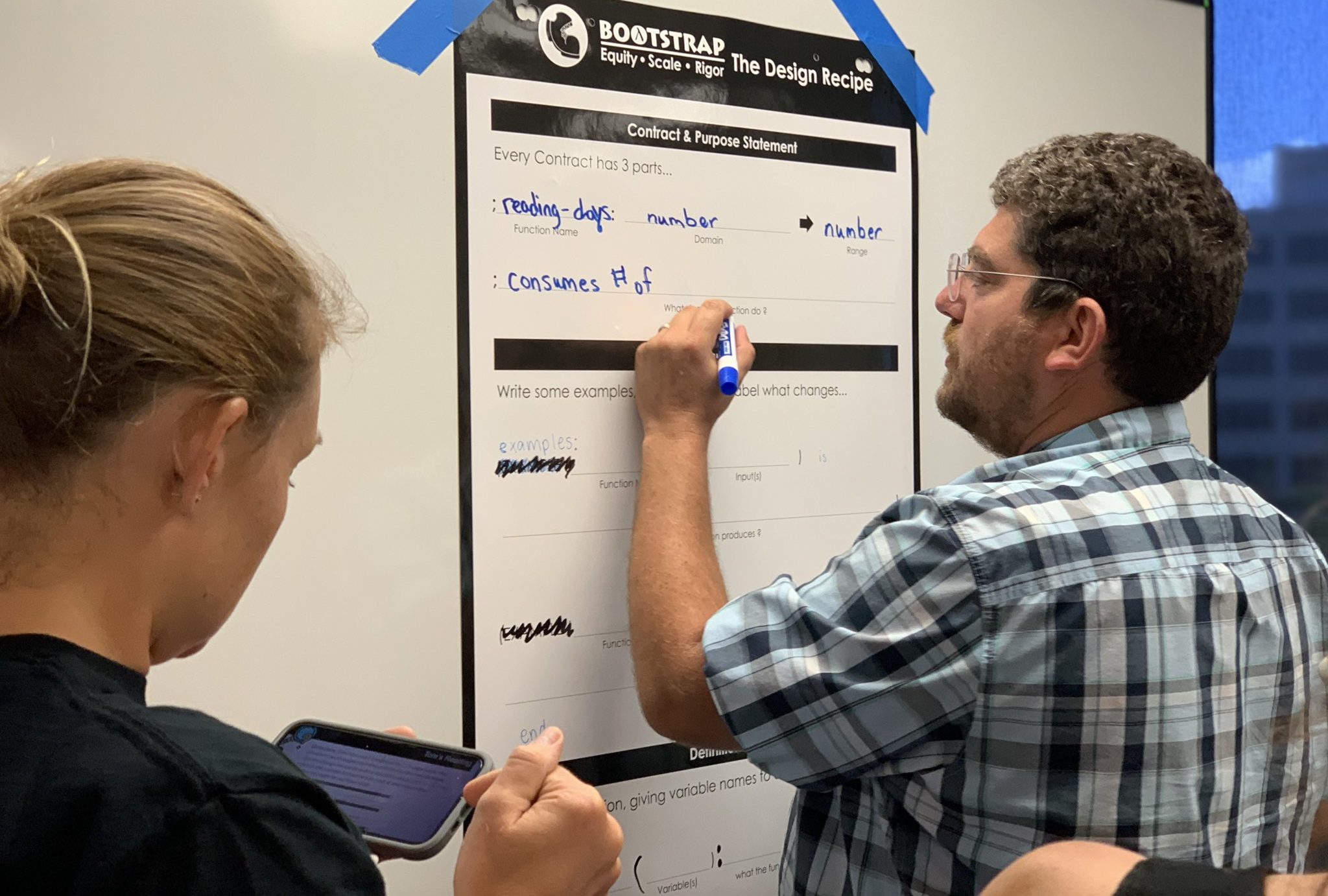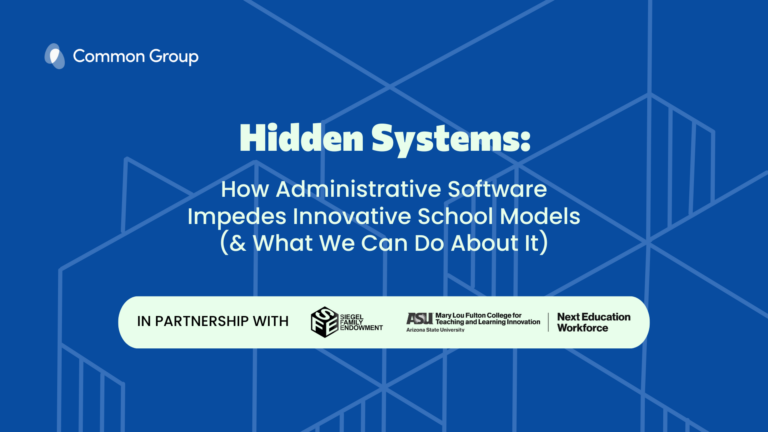
How Bootstrap works with teachers, schools, and districts to provide CS and DS modules and professional development that can be integrated across subjects and within standards
Computer science (CS) and data science (DS) shouldn’t be limited to CS or DS classes, and should be based on rigorous research. Those are the clarion calls of Bootstrap, an organization that provides free, research-backed computer science and data science modules and paid professional development workshops to K-12 teachers for integration across a wide set of disciplines.
The program was developed by a team with expertise in computing education, math education, computer science, and programming language design and implementation. The team co-designs the curriculum, pedagogy, programming languages, and software tools, continually refining them based on research and assessment. By building all of their own components, Bootstrap can create materials that support learning goals in a wide range of disciplines. The organization’s ability to bring computing and data science to where students already are, rather than assume students will come to a standalone course, is one reason why the program has been so effective in reaching girls, Black, and Latinx students.
In this interview, we spoke with Dr. Kathi Fisler, a Founder and Board Member at Bootstrap and Research Professor of Computer Science at Brown University to find out more about Bootstrap’s computer science and data science curriculum, why a mix-and-match strategy for partnering with teachers and districts is important, and why context matters when it comes to advancing equity in teaching and learning.
In K-12 education, we hear a lot about computer science education and coding. We generally hear comparatively less about data science education, one of the focus areas of your work at Bootstrap. In your words, what is data science?
Frankly, trying to define data science is as futile as trying to define “computational thinking.” Data science is a rich area with many possible emphases. Instead, we prefer to define a model of what belongs in data science. We believe that a strong and equitable data science curriculum combines four ingredients: domains of study, statistics & mathematics, computing, and civic responsibility. (See our blog post on this for more detail.)
Once you include domains of study, data science can fit into any discipline. But as it does so, it is important to bring in each of the other three domains, otherwise you miss key perspectives that underlie data science in practice.
Why is it so important that data science be a part of K-12 education?
Data science belongs in K-12 education because our lives are increasingly influenced and impacted by data. For most students, data will be used to make decisions that impact themselves and their communities. For others, working with data will be part of their professions. It’s an essential modern literacy.
As we celebrate CS Ed Week, what do you wish that more people understood about computer science education?
Computer science should not be defined by being able to write programs with conditionals, sequences, and explicit loops. Data science education centers none of these, for example, but still teaches core computational skills of decomposition, pattern recognition, abstraction, and programming.
There also isn’t enough consideration of trustworthiness of computations in most K-12 efforts. Students are taught to create computational artifacts, but rarely to think about whether those artifacts can be trusted to do what we want them to do. Programs can have bad outcomes; the rise in calls to reign in automated-decision making systems attests to that. Shouldn’t we be building in habits of thinking about what an artifact should and shouldn’t do as students start to learn to write code? We do this in Bootstrap, but few other curricula do, and few CS standards call for this content either.
Is there something about the skill set taught through computer science or the approach that the discipline takes that makes it an important area of investment in making our society more equitable overall?
Putting computing in all schools won’t inherently make things more equitable. Not all curricula are equally strong, not all schools have the resources of teachers who know how to teach CS well, and so on. There’s no magic bullet in teaching CS.
From an equity perspective, our goal should be to help all students gain foundational skills that they need to live and work in the world as adults. For many students, strengthening their understanding of mathematics or providing education that helps build strong executive function skills would be far more valuable than having them take an intro CS class.
More research is needed to determine whether and how CS plays a role in developing these skills. But at the same time, we have to think about how to deploy CS in ways that it can reach most students in equitable ways. We believe an integration approach is essential for reaching students at scale, and for helping teachers grow into computing over time.
At Bootstrap, you offer research-backed curricula and professional development opportunities for middle and high school teachers. You’ve also partnered with school districts to extend these resources across entire systems. How effective is this combined strategy of educator engagement and district approach in advancing equity and scaling your programming to more learners?
The combined strategy is essential because new materials enter different districts in different ways. Some districts give teachers flexibility in how they teach content, while others strictly follow district-wide curricula. Sometimes, an individual teacher gets excited about Bootstrap, shows it to colleagues, and interest builds from the bottom up. Other times, a district or school administrator is looking at the big picture and wants to bring in our curriculum moving top-down. We’ve had success stories of both forms (and some in between). Multiple pathways into CS education helps us figure out how to best work with the context of particular schools and districts.
What have you learned so far about what makes partnerships with teachers and school districts successful?
The most important thing we’ve learned is that teachers who are new to computing or data science grow into these areas over time, especially if they are trying to integrate the content into an existing curriculum (rather than teach a standalone class). With some of our larger-scale partnerships, we’ve had some teachers attend the initial training workshop multiple times, each time picking up a bit more and integrating a bit more. The model of “let’s show you an entire curriculum in one professional development (PD) session and set you off” has been effective with very few teachers. Many of our teachers worked with the materials in very small scale ways for a couple of years before they felt comfortable moving on. But many do start to move on, and that’s when the effort begins to stick.
Earlier you asked about how this interacts with equity. Part of teaching equitably means recognizing that context is different from school to school.
Curricular materials need to be sufficiently flexible so that teachers can adapt them to different situations while still teaching foundational concepts. Curricular materials need to be usable in small chunks that build on each other so that learning can grow along with the students and teachers. And materials need to be designed to fit into the disciplines where the students and teachers already are.
When you design for integration, as Bootstrap does, you can’t define a CS or DS curriculum in isolation and hand it off. You have to understand how CS or DS can complement and enhance what the teacher already wanted their students to learn. The approach is teacher- and student-centric, while also presenting a strong core of material that can extend to solving different kinds of problems.
In New Mexico and Michigan, you’re also engaged in a number of projects to redesign statewide data science pathways that align to state standards and curricular guidelines. Could you explain the value of these pathways?
Teachers are extraordinarily busy (among other things). Curriculum providers need to reduce the friction needed to try out new materials. Our pathways attempt to remove the question of “how does this fit into what I’m already required to do.” They show teachers how new content can be integrated within state or district regulations, making that one fewer thing a teacher needs to worry about.
How does this statewide work impact your work with individual teachers and school districts, particularly when it comes to outreach to educators?
Statewide work helps signal that someone higher up has vetted our materials and our approach. This matters not only at the level of individual materials, but also at the level of the philosophy behind the content and instruction. With so many computer science and data science curricula out there, and so many answers to “what is data science,” teachers new to these areas can find it overwhelming to figure out what makes sense for their students.
Statewide efforts can also assure teachers that there will be a community of other teachers working within their state context trying to figure out how to teach the content in similar ways.
At Bootstrap, you conduct rigorous evaluations and impact studies of your initiatives. From this work, what are you learning about the features of computer science and data science curricula and training that are most impactful for teachers and students?
Teacher experience is essential. Without a strong teacher experience, you never get to access the students. Our expertise lies in working with teachers who want to integrate computing or data science into their existing courses. Teachers really start to buy into integrating content when they realize that the new content is changing how they themselves understand their primary discipline.
We’ve seen many math teachers in our Oklahoma partnership start to understand how the concept of a function is enriched by working with functions over strings or that compose images. In our project that is creating data-science enhanced social studies materials for 5th graders, we see teachers get excited by learning how to use Google Sheets and realizing that they can bring data into discussions without having to identify as a “math person.” Experiences like these are essential if we’re going to prepare teachers to in turn prepare all students to have foundational skills that they need to live, work, and thrive as adults in the future.
Kathi Fisler, PhD is a Founder and Board Member of Bootstrap. She is also Research Professor of Computer Science at Brown University where she studies computing education in grades 5-16.
Read more about Bootstrap here.





